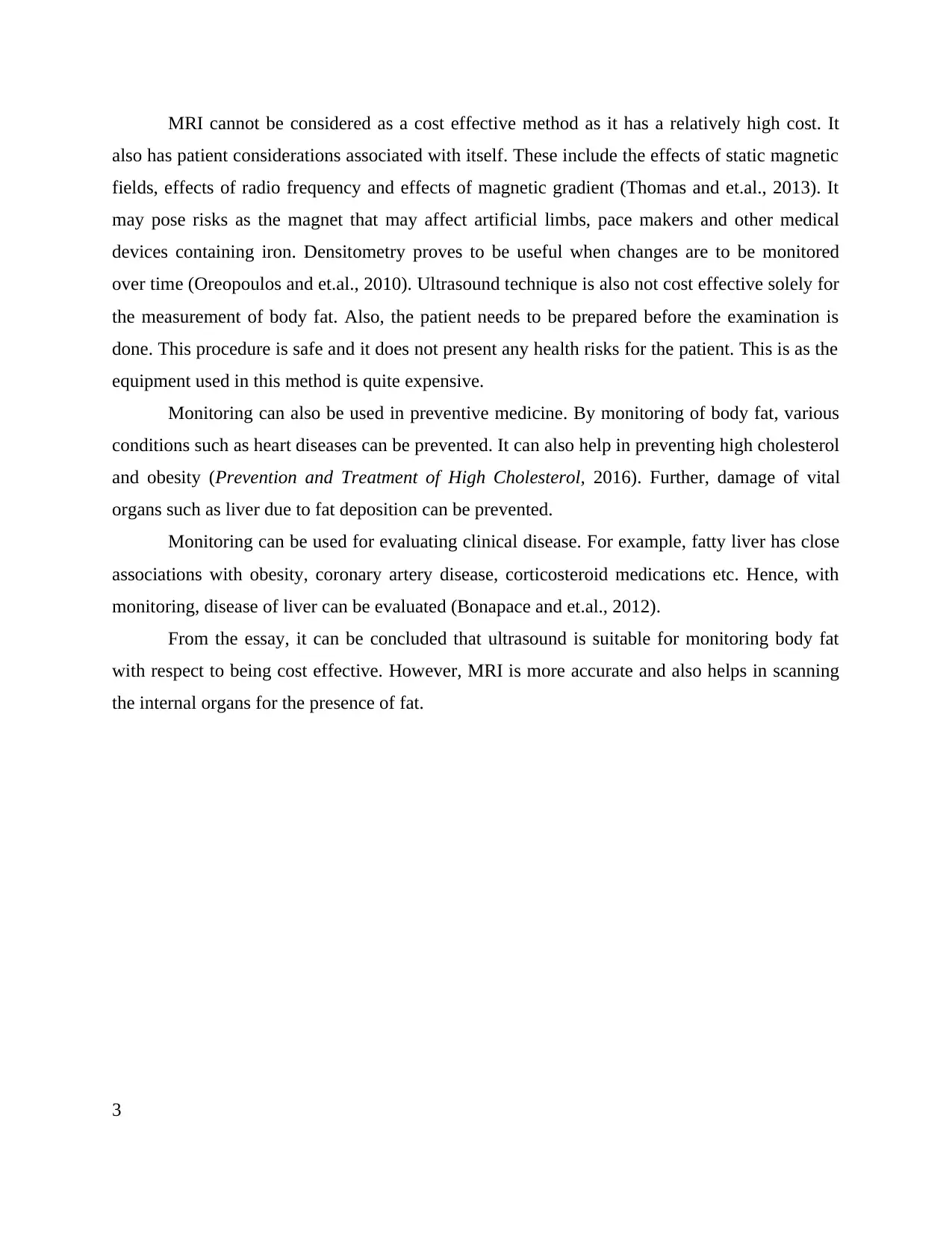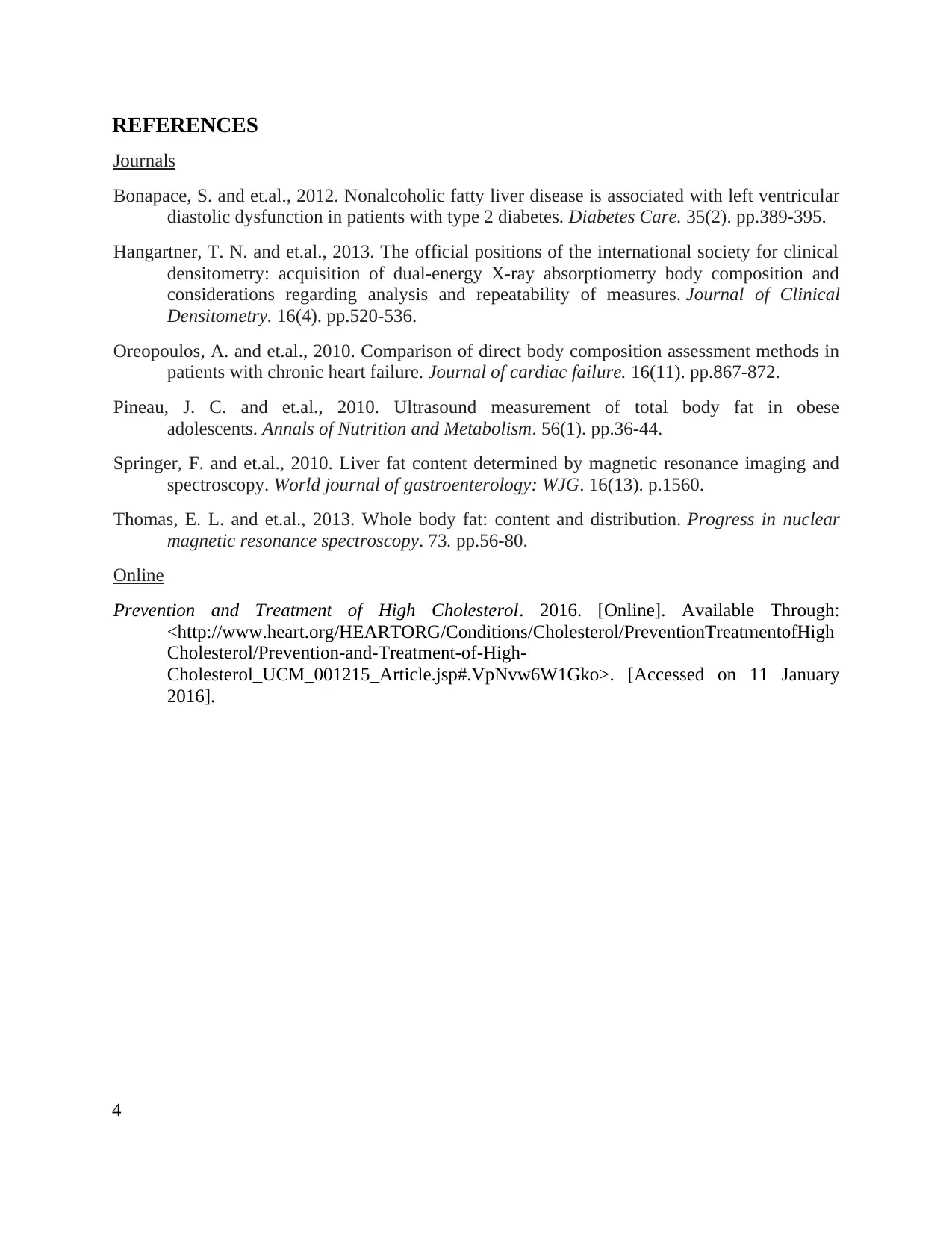Clinical Techniques for the Assessment of Body Fat and Health Risks
VerifiedAdded on 2020/01/15
|4
|983
|194
Essay
AI Summary
This essay examines various techniques for monitoring human body fat, including MRI, ultrasound, and densitometry, providing a comparative analysis of their effectiveness. It discusses the advantages and disadvantages of each method, such as MRI's ability to scan individual organs and ultrasound's accurate measurement of subcutaneous fat. The essay also considers the cost-effectiveness, risks, and patient considerations associated with each technique. It highlights the role of body fat monitoring in preventive medicine, such as preventing heart disease and fatty liver. The conclusion emphasizes the suitability of ultrasound as a cost-effective method, while acknowledging MRI's accuracy in scanning internal organs for fat. The essay references several journals and online resources to support its findings, offering a comprehensive overview of the clinical evidence in biomedical sciences related to body fat assessment.

Clinical evidence in
biomedical sciences
biomedical sciences
Paraphrase This Document
Need a fresh take? Get an instant paraphrase of this document with our AI Paraphraser

The human body is made up of two components known as fat mass and lean body mass.
Although, fat is required by the human body to survive, excess of it poses several risks and
harms for an individual. It is for this reason that greater importance has been assumed by
assessment of body fat levels (Springer and et.al., 2010). There are various techniques which can
be used for monitoring human body fat. However, it is important to determine if these techniques
are suitable for the measurement of fat in human body. The present essay discusses various
techniques that are suitable for monitoring human body fat such as MRI, ultrasound,
densitometry, Duel Energy X-Ray Absorptiometry etc. In the essay, relative advantages and
disadvantages of these techniques have been discussed. Along with that, risk, cost effectiveness
and patient considerations have also been taken into account.
Various techniques can be used for the assessment of body fat. These include MRI,
ultrasound, densitometry etc. In order to assess the suitability of these techniques, their relative
advantages and disadvantages can be determined. MRI or magnetic resonance imaging is an
imaging technique which is used for estimating the volume of adipose tissue. It provides high
quality imaging data in the form of “imaging slices” with the help of which regional tissue
volumes can be calculated. The advantage of using MRI is that it not only helps in scanning the
whole body for fat but also scans individual organs (Springer and et.al., 2010). Hence, fat content
of individual organs can be measured. However, MRI discerns only that fat mass which is
present in the adipose tissue.
Densitometry is effective at distinguishing between fat mass and fat free mass. This
technique has better precision than hydrodensitometry for monitoring fat in children. However,
the disadvantage is that densitometry may lead to overestimation of fatness (Hangartner and
et.al., 2013). Ultrasound is extensively used for measuring tissue structure. This technique has
advantage that it accurately measures subcutaneous fat thickness. It also quantifies intramuscular
fat. However, the disadvantage of this method is that it may mistake fascia for the boundary layer
between muscle and subcutaneous fat. Hence, it requires considerable skills, practice and
training (Pineau and et.al., 2010).
2
Although, fat is required by the human body to survive, excess of it poses several risks and
harms for an individual. It is for this reason that greater importance has been assumed by
assessment of body fat levels (Springer and et.al., 2010). There are various techniques which can
be used for monitoring human body fat. However, it is important to determine if these techniques
are suitable for the measurement of fat in human body. The present essay discusses various
techniques that are suitable for monitoring human body fat such as MRI, ultrasound,
densitometry, Duel Energy X-Ray Absorptiometry etc. In the essay, relative advantages and
disadvantages of these techniques have been discussed. Along with that, risk, cost effectiveness
and patient considerations have also been taken into account.
Various techniques can be used for the assessment of body fat. These include MRI,
ultrasound, densitometry etc. In order to assess the suitability of these techniques, their relative
advantages and disadvantages can be determined. MRI or magnetic resonance imaging is an
imaging technique which is used for estimating the volume of adipose tissue. It provides high
quality imaging data in the form of “imaging slices” with the help of which regional tissue
volumes can be calculated. The advantage of using MRI is that it not only helps in scanning the
whole body for fat but also scans individual organs (Springer and et.al., 2010). Hence, fat content
of individual organs can be measured. However, MRI discerns only that fat mass which is
present in the adipose tissue.
Densitometry is effective at distinguishing between fat mass and fat free mass. This
technique has better precision than hydrodensitometry for monitoring fat in children. However,
the disadvantage is that densitometry may lead to overestimation of fatness (Hangartner and
et.al., 2013). Ultrasound is extensively used for measuring tissue structure. This technique has
advantage that it accurately measures subcutaneous fat thickness. It also quantifies intramuscular
fat. However, the disadvantage of this method is that it may mistake fascia for the boundary layer
between muscle and subcutaneous fat. Hence, it requires considerable skills, practice and
training (Pineau and et.al., 2010).
2

MRI cannot be considered as a cost effective method as it has a relatively high cost. It
also has patient considerations associated with itself. These include the effects of static magnetic
fields, effects of radio frequency and effects of magnetic gradient (Thomas and et.al., 2013). It
may pose risks as the magnet that may affect artificial limbs, pace makers and other medical
devices containing iron. Densitometry proves to be useful when changes are to be monitored
over time (Oreopoulos and et.al., 2010). Ultrasound technique is also not cost effective solely for
the measurement of body fat. Also, the patient needs to be prepared before the examination is
done. This procedure is safe and it does not present any health risks for the patient. This is as the
equipment used in this method is quite expensive.
Monitoring can also be used in preventive medicine. By monitoring of body fat, various
conditions such as heart diseases can be prevented. It can also help in preventing high cholesterol
and obesity (Prevention and Treatment of High Cholesterol, 2016). Further, damage of vital
organs such as liver due to fat deposition can be prevented.
Monitoring can be used for evaluating clinical disease. For example, fatty liver has close
associations with obesity, coronary artery disease, corticosteroid medications etc. Hence, with
monitoring, disease of liver can be evaluated (Bonapace and et.al., 2012).
From the essay, it can be concluded that ultrasound is suitable for monitoring body fat
with respect to being cost effective. However, MRI is more accurate and also helps in scanning
the internal organs for the presence of fat.
3
also has patient considerations associated with itself. These include the effects of static magnetic
fields, effects of radio frequency and effects of magnetic gradient (Thomas and et.al., 2013). It
may pose risks as the magnet that may affect artificial limbs, pace makers and other medical
devices containing iron. Densitometry proves to be useful when changes are to be monitored
over time (Oreopoulos and et.al., 2010). Ultrasound technique is also not cost effective solely for
the measurement of body fat. Also, the patient needs to be prepared before the examination is
done. This procedure is safe and it does not present any health risks for the patient. This is as the
equipment used in this method is quite expensive.
Monitoring can also be used in preventive medicine. By monitoring of body fat, various
conditions such as heart diseases can be prevented. It can also help in preventing high cholesterol
and obesity (Prevention and Treatment of High Cholesterol, 2016). Further, damage of vital
organs such as liver due to fat deposition can be prevented.
Monitoring can be used for evaluating clinical disease. For example, fatty liver has close
associations with obesity, coronary artery disease, corticosteroid medications etc. Hence, with
monitoring, disease of liver can be evaluated (Bonapace and et.al., 2012).
From the essay, it can be concluded that ultrasound is suitable for monitoring body fat
with respect to being cost effective. However, MRI is more accurate and also helps in scanning
the internal organs for the presence of fat.
3
⊘ This is a preview!⊘
Do you want full access?
Subscribe today to unlock all pages.

Trusted by 1+ million students worldwide

REFERENCES
Journals
Bonapace, S. and et.al., 2012. Nonalcoholic fatty liver disease is associated with left ventricular
diastolic dysfunction in patients with type 2 diabetes. Diabetes Care. 35(2). pp.389-395.
Hangartner, T. N. and et.al., 2013. The official positions of the international society for clinical
densitometry: acquisition of dual-energy X-ray absorptiometry body composition and
considerations regarding analysis and repeatability of measures. Journal of Clinical
Densitometry. 16(4). pp.520-536.
Oreopoulos, A. and et.al., 2010. Comparison of direct body composition assessment methods in
patients with chronic heart failure. Journal of cardiac failure. 16(11). pp.867-872.
Pineau, J. C. and et.al., 2010. Ultrasound measurement of total body fat in obese
adolescents. Annals of Nutrition and Metabolism. 56(1). pp.36-44.
Springer, F. and et.al., 2010. Liver fat content determined by magnetic resonance imaging and
spectroscopy. World journal of gastroenterology: WJG. 16(13). p.1560.
Thomas, E. L. and et.al., 2013. Whole body fat: content and distribution. Progress in nuclear
magnetic resonance spectroscopy. 73. pp.56-80.
Online
Prevention and Treatment of High Cholesterol. 2016. [Online]. Available Through:
<http://www.heart.org/HEARTORG/Conditions/Cholesterol/PreventionTreatmentofHigh
Cholesterol/Prevention-and-Treatment-of-High-
Cholesterol_UCM_001215_Article.jsp#.VpNvw6W1Gko>. [Accessed on 11 January
2016].
4
Journals
Bonapace, S. and et.al., 2012. Nonalcoholic fatty liver disease is associated with left ventricular
diastolic dysfunction in patients with type 2 diabetes. Diabetes Care. 35(2). pp.389-395.
Hangartner, T. N. and et.al., 2013. The official positions of the international society for clinical
densitometry: acquisition of dual-energy X-ray absorptiometry body composition and
considerations regarding analysis and repeatability of measures. Journal of Clinical
Densitometry. 16(4). pp.520-536.
Oreopoulos, A. and et.al., 2010. Comparison of direct body composition assessment methods in
patients with chronic heart failure. Journal of cardiac failure. 16(11). pp.867-872.
Pineau, J. C. and et.al., 2010. Ultrasound measurement of total body fat in obese
adolescents. Annals of Nutrition and Metabolism. 56(1). pp.36-44.
Springer, F. and et.al., 2010. Liver fat content determined by magnetic resonance imaging and
spectroscopy. World journal of gastroenterology: WJG. 16(13). p.1560.
Thomas, E. L. and et.al., 2013. Whole body fat: content and distribution. Progress in nuclear
magnetic resonance spectroscopy. 73. pp.56-80.
Online
Prevention and Treatment of High Cholesterol. 2016. [Online]. Available Through:
<http://www.heart.org/HEARTORG/Conditions/Cholesterol/PreventionTreatmentofHigh
Cholesterol/Prevention-and-Treatment-of-High-
Cholesterol_UCM_001215_Article.jsp#.VpNvw6W1Gko>. [Accessed on 11 January
2016].
4
1 out of 4
Related Documents
Your All-in-One AI-Powered Toolkit for Academic Success.
+13062052269
info@desklib.com
Available 24*7 on WhatsApp / Email
![[object Object]](/_next/static/media/star-bottom.7253800d.svg)
Unlock your academic potential
Copyright © 2020–2025 A2Z Services. All Rights Reserved. Developed and managed by ZUCOL.




